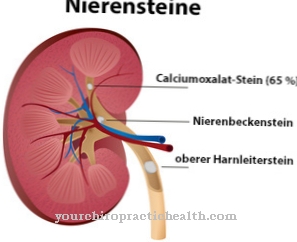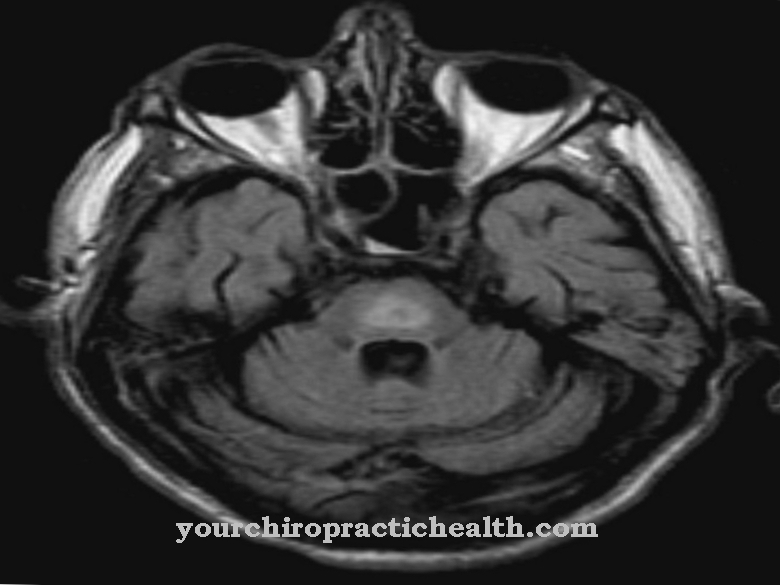At the Antley-Bixler Syndrome it is a genetically caused disease, the incidence of which in the population is generally relatively low. The commonly used abbreviation for the disease is ABS. So far, around 50 cases of illness in people are known and described. Basically, Antley-Bixler syndrome occurs in men and women alike.
What is Antley-Bixler Syndrome?

© Dan Race - stock.adobe.com
Antley-Bixler syndrome got its name from two doctors from the United States of America, Antley and Bixler. These two doctors first described the disease in 1975. The disease is usually associated with a typical combination of various symptoms. In the majority of cases, the affected patients suffer from hypoplasia of the midface.
In this context, a so-called craniosynostosis can also be seen. The femur may be bent and the joints may have contractures. The sick patients also show a certain type of synostosis. The affected children already show numerous characteristic symptoms.
A relatively high and broad forehead can be seen, which usually has a strong bulge towards the front. In many cases the ears are characterized by malformations, while the nose of the diseased patient appears comparatively flat. Patients differ in terms of their intelligence and mental development.
Basically, a distinction is made between two different types of Antley-Bixler syndrome, type 1 and type 2. Genital malformations occur primarily in type 2. In principle, the disease is inherited as an autosomal recessive or an autosomal dominant trait.
causes
Basically, the Antley-Bixler syndrome is a genetic disease. There are two forms of the disease, which are genetically different. Type 1 is based on gene mutations in the so-called POR gene, which are inherited in an autosomal recessive manner. Type 2, on the other hand, is primarily triggered by genetic mutations on the FGFR2 gene.
In this case there is an autosomal dominant inheritance pattern. In addition to the genetic factors, there are other causes that may lead to the typical symptoms of Antley-Bixler syndrome. Pregnant women who take the medicinal substance fluconazole during the first few months of pregnancy sometimes have children with the typical symptoms and signs of Antley-Bixler syndrome. Fluconazole is an antifungal agent.
Symptoms, ailments & signs
In the context of Antley-Bixler syndrome, the sick people experience various symptoms. In numerous cases, the sutures of the skull bone ossify too early, which is known in medical terminology as craniosynostosis. Sometimes the rear opening of the nose is missing or it is severely narrowed. Some patients have bent bones in the thigh area.
Sometimes people also suffer from camptodactyly and so-called arachnodactyly. Some sick patients have deformities in the anatomy of the heart, in the area of the vertebrae and the anus. In addition, some of the people affected have malformations around the urogenital area. For example, intersex sexual organs are possible because the formation of steroids is not the same as in healthy people.
Diagnosis & course
The typical symptoms and signs of Antley-Bixler syndrome often indicate the disease relatively clearly even in young patients. However, due to the rarity of the syndrome, diagnosis is not easy in some cases. If parents or doctors discover external malformations in newborns or infants, further examinations must be ordered immediately.
First, a so-called anamnesis is carried out, whereby the symptoms are analyzed. Since many of the symptoms of Antley-Bixler syndrome exist and are evident from birth, the suspicion usually falls quickly of a hereditary disease. In this context, the family history is very important. Similar cases in the family may already indicate the disease.
The individual symptoms of the patient are analyzed in detail during clinical examinations. The malformations of the skeleton can be proven with the help of x-ray examinations, for example. This shows, for example, the bending of certain bones. Anomalies in the area of the face, such as an unusually bulging forehead and a flat nose, are easily recognizable and indicate the disease.
Ultimately, a genetic test enables a comparatively reliable diagnosis of Antley-Bixler syndrome. In this way, the responsible gene mutations on the corresponding genes can be identified. It can also be determined which of the two types of disease the patient is suffering from.
Complications
Most of the patients suffer from a malformation of the midface. Premature ossification of the cranial sutures is characteristic, some of which manifests itself before birth and is known as craniosynostosis. Other complications are ossification of the joints and a high, strongly arched forehead.
The ears are often malformed and the nose is flatter than in healthy people. The posterior nostril is missing or severely narrowed. The development of intelligence is differently pronounced. Further disorders are malformations of the fingers and deformities in the area of the vertebrae, the anatomy of the heart and the anus.
Malformations can also affect the urogenital area, whereby intersex sexual organs are possible. Basically, the Antley-Bixler syndrome is divided into type 1 and type 2, whereby female and male patients are equally affected. The malformations of the genitals are assigned to type 2. The affected children show typical symptoms and complications already at birth or in the first years of life.
However, since this autosomal dominant or autosomal recessive inherited malformation syndrome occurs extremely rarely, a final diagnosis is difficult. The causes of this hereditary disease cannot be treated. However, individual therapeutic approaches are possible in order to increase the quality of life and life expectancy of the patient.
The cases of illness known to date show, however, that the prognosis is comparatively negative, as most patients die in childhood due to multiple organic disorders and complications.
When should you go to the doctor?
If parents notice any external malformations in their child, a doctor should be called in immediately. The hereditary disease must always be diagnosed in order to enable treatment of the various symptoms. Ideally, the diagnosis is made before birth.
Parents with a corresponding medical history - for example, if the family has cases of Antley-Bixler syndrome or other hereditary diseases - should address this during the ultrasound examination. The doctor responsible can examine the embryo specifically for malformations and, if there is a specific suspicion, arrange a genetic test.
At the latest after the birth, the external characteristics are usually recognized by the obstetrician or the parents themselves. The diagnosis of Antley-Bixler syndrome is then routinely made. Since the disease can only be treated symptomatically so far, further visits to the doctor are usually necessary.
Emergency situations arise, for example, when the child cannot breathe properly due to ossification of the nose and mouth. Circulatory problems, digestive problems, and other health problems that can occur with Antley-Bixler syndrome also need to be treated promptly by a doctor.
Doctors & therapists in your area
Treatment & Therapy
Basically, with Antley-Bixler syndrome it is not possible to treat the causes of the disease. For this reason, only the symptoms are treated in order to reduce the symptoms of the sick patient as much as possible. In the majority of cases, the children concerned receive intensive medical, educational and social care in order to improve their quality of life and to relieve the burden on those with custody.
However, previous cases of illness show that the prognosis for the disease is relatively poor. Most of the people affected die as children. The reason for this is often serious breathing problems.
Outlook & forecast
A recovery from Antley-Bixler syndrome is not possible without consulting a doctor. In the natural course, the genetic defect does not lead to any alleviation of the symptoms, as the malformations remain lifelong. Individual symptoms can be treated with medical care. A complete healing is still not possible. In addition, with Antley-Bixler syndrome, the normal lifespan is significantly shortened. A large number of the sick die in childhood. For legal reasons, human genetics must not be interfered with.
Only with the help of surgery and laser technology can corrections of individual malformations be carried out if desired and required. These increase general well-being and help improve the quality of life. Nevertheless, there is a risk of side effects or immune reactions from the body through the interventions. Inflammation occurs and mental problems can develop.
Treatment of the additional diseases is associated with a good prognosis in most cases. Only rarely is there an infestation of germs that minimizes the chances of recovery. Since the underlying disease cannot be cured and it is already associated with a significant reduction in lifespan, a thorough check should be made to determine whether further corrections improve the functioning of the organism.
prevention
Antley-Bixler syndrome is a genetic disease, so there are currently no options for causal prevention of the disease. Only symptomatic treatment of the disease is possible.
Aftercare
In most cases, direct follow-up care is not possible with Antley-Bixler syndrome. Since this disease is a hereditary disease, it cannot be treated completely and only symptomatically. A cure is not achieved. If those affected want to have children, genetic counseling can also be carried out to prevent Antley-Bixler syndrome from being inherited.
As a rule, patients with Antley-Bixler syndrome are dependent on the intake of medication. There are no further complications, although care should be taken to take the medication correctly and, above all, regularly. Above all, parents must ensure that their children are taking the medication correctly. If necessary, possible interactions with other drugs should also be clarified with a doctor.
Since the Antley-Bixler syndrome can also lead to malformations of the heart, the patient should undergo regular heart examinations. The sexual organs can also be affected and should also be examined. Furthermore, contact with other people affected by Antley-Bixler syndrome can also have a positive effect on the further course of the disease, as this leads to an exchange of information. Whether the Antley-Bixler syndrome leads to a reduced life expectancy cannot be universally predicted.
You can do that yourself
Patients with Antley-Bixler syndrome are enormously restricted in their quality of life due to the disease. Those affected often require intensive medical care from birth. The deformities of internal organs such as the heart are different in individual cases, but corrective surgical interventions are only partially possible.
In the event of any operations, the parents assist their sick children while they are in the clinic. However, numerous therapeutic approaches are purely symptomatic in nature. In addition, the disease often negatively affects the life expectancy of those affected and causes early death, often in childhood.
For example, patients have severe difficulty breathing, so strenuous physical activity must be avoided as a matter of urgency. Regular appointments with various medical specialists who monitor the health of those affected are mandatory. If requested by the parents and the sick child's cognitive abilities allow it, they can visit a special educational institution.
In numerous cases, the patients need palliative care because the symptoms make survival impossible. The parents suffer enormously from the disease and therefore sometimes develop depression. Then it is advisable to seek psychotherapeutic treatment immediately so that the custodians can continue to be there for their child.




.jpg)






















